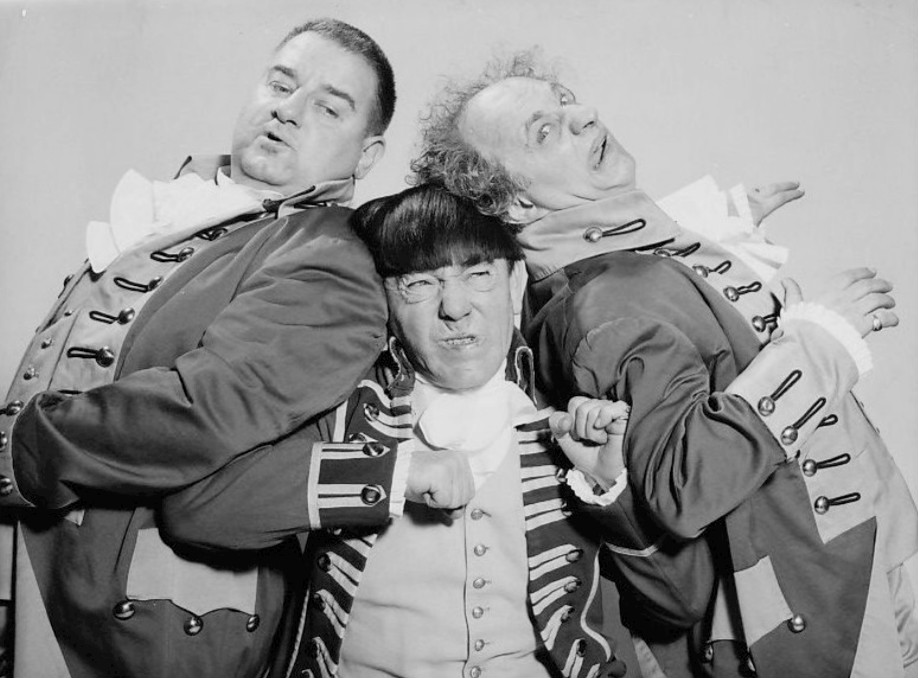Finding endless amusement in the brutal simplicity of no-frills slapstick, the Three Stooges are, depending on who you ask, the premier practitioners of physical comedy of their era, or the epitome of brain-dead foolishness. Whichever side of the argument you fall on, there can be little doubt that their consistency is nothing less than astonishing. The Three Stooges–Moe (Moses Horowitz), Larry (Larry Feinberg), and Curly (Jerome Horowitz), occasionally joined by Shemp (Samuel Horowitz)–were a film and television sensation for more than three decades in the mid-20th century.
The First Stooges
The Horowitz brothers, Moe, Curly, and Shemp, were born to a moderately prosperous Jewish immigrant family in Brooklyn. Their mother Jennie was a successful real-estate agent, although she could barely speak English, and their father Solomon was a fabric cutter. Samuel was born in 1895, Moses in 1897, and Jerome, the youngest, was born in 1903. By the time Moe was in his early twenties, he was a regular on stage, appearing with the Marguerite Bryant Players, a theatre troupe in Pennsylvania. Shemp, meanwhile, had steady work in vaudeville.

Moe and Shemp shot a number of short sports-themed comedies with Hall of Fame baseball player Honus Wagner in 1919 before encountering old friend Larry Fine (nee Feinberg), who had been scratching out a living in show business as well. Moe, Shemp, and Larry were hired by comedian Ted Healy in the early 1920s, to play his sidekicks. Healy was the comedian, the main act, and Moe, Shemp, and Larry were his stooges–audience plants plucked from the crowd to play along with Healy’s carefully planned routines. Healy offered them each only $100 or $150 a week, though he was raking in nearly $2,000 a week.
Shemp left the Three Stooges, as they came to be called, in the early 1930s, and Moe, the unquestioned lead Stooge, brought in his younger brother Curly as the new third member.
In the Movies
After a triumphant performance in front of a crowd of studio executives, the Stooges signed with MGM in 1933 to produce short films with Healy. The self-consciously classy studio did not fit well with the defiantly lowbrow Three Stooges. After Healy ditched his sidekicks in 1934, believing them to be holding him back from greater successes, the Stooges signed with Columbia, then considered the crassest of the major film studios. There they would rocket to success.

Help us keep Jewish knowledge accessible to millions of people around the world.
Your donation to My Jewish Learning fuels endless journeys of Jewish discovery. With your help, My Jewish Learning can continue to provide nonstop opportunities for learning, connection and growth.
The Stooges’ film routines were mostly slapstick, preferring hitting to discussing, and they used soundtrack as both amplifier and audience guides. Exaggerated sounds–ukuleles, twittering birds, and ringing bells–permitted audiences to laugh at punches, counter-punches, and bonks on the head that might otherwise have seemed excessive.
Not everyone found their comedy palatable. Audiences used to more refined comedy have struggled to understand the appeal of the relentlessly violent Stooges shtick. Even their mother failed to grasp her sons’ routines. Seeing one of their original shorts in a movie theater, she grew so riled up at the beatings Healy was dishing out that she began waving an umbrella at the screen and shouting curses in Yiddish at the evildoer who was clobbering her boys.

The Three Stooges rarely made much of their Jewish heritage. All three Horowitz brothers changed their last names to Howard and employed a mostly physical brand of comedy that did little to disclose their roots. If you look closely, though, you can see the violence that energizes their work as an expression of immigrant familial love, doled out in pokes and prods rather than hugs and kisses. As working stiffs forever outsmarting and outhustling a world of fatally incompetent bluebloods, the Stooges’ antics were symbolic of their own triumphant brand of unapologetically blue-collar comedy.
Undercover Brothers
One of the few times the Stooges acknowledged their religious roots onscreen was in perhaps their most memorable film, You Nazty Spy! (1940). Moe is a housepainter hired as the dictator of the fictional country of Moronica. With his greasepaint mustache and occasional lapse into gibberish German, he is a dead ringer, not only for Adolf Hitler, but for Charlie Chaplin’s Hitlerian Adenoid Hynkel, from The Great Dictator, released later that same year.
Nazty is riddled with Jewish humor, as if ethnic and religious pride was the Three Stooges’ prime weapon in their arsenal of anti-Nazi munitions. Greeting their Nazi bosses, the Stooges leap back and salute: “shalom aleichem!” Moe proposes a blitzkrieg, and Curly strenuously agrees: “I just love blintzes. Especially with sour cream.” A slinky temptress named Maddy Herring (get it?) offers her favors, and Curly is relieved when Moe avoids temptation: “You’d have been in some pickle with that Herring.”
You Nazty Spy! ends with Moe, Larry, and Curly unceremoniously eaten by lions, but the Moronican backdrop was brought back for I’ll Never Heil Again (1941). Heil is a more traditionally loony Stooges short, with Moe shooting shaving cream through the telephone at an impudent Curly, and Curly exhaling fire after sucking on a radiator pipe instead of his tobacco pipe.
An Unending Circle of (Comic) Violence
The Stooges appeared to have reached the end of their run in the late 1940s, when they were unexpectedly saved by the arrival of a new medium. Columbia licensed their shorts to television, which was still hungry for anything to fill airtime. On television, the Stooges appealed to a generation of children unfamiliar with their work. Columbia had unceremoniously dropped the Three Stooges after a series of disappointing films, but quickly brought them back upon discovering their undimmed appeal.
In this later era, illness and death made for numerous cast changes, and the films themselves were often hastily re-edited hodgepodges of older footage. Having begun onscreen in the early 1930s, the Stooges were still making films as late as 1968’s Star Spangled Salesman. The Three Stooges retained their popularity, even when they were of an age more suited to retirement than fisticuffs. (Moe was still taking blows–and giving them out!–at over 70 years of age.) Today, the Three Stooges seem to belong to no era at all. Their stupidity is timeless.



